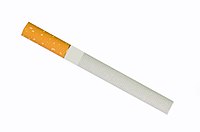
Photo from wikipedia
In the aquatic environment, pharmaceutical drugs are submitted to degradation processes, where photodegradation is one of the most important mechanisms affecting the fate, persistence and toxicity of the compounds. Carbamazepine,… Click to show full abstract
In the aquatic environment, pharmaceutical drugs are submitted to degradation processes, where photodegradation is one of the most important mechanisms affecting the fate, persistence and toxicity of the compounds. Carbamazepine, a widely used antiepileptic, is known to suffer photodegradation in water bodies and generate photoproducts, some of them with higher potential toxicity than the parent compound. Therefore, to evaluate the toxic effects of CBZ when combined with its photoproducts, an acute exposure (96h) with the edible clam Scrobicularia plana was performed using environmental concentrations of CBZ (0.00-9.00μg/L) irradiated (and non-irradiated) with simulated solar radiation. The analysis of the irradiated CBZ solutions by mass spectrometry revealed the formation of 5 photoproducts, including acridine (a compound known to be carcinogenic). Oxidative stress results showed that the exposure to CBZ photoproducts did not increase the toxicity to clams, by comparison with the parent compound. Lipid peroxidation levels, catalase and superoxide dismutase activities were the most responsive parameters to these stressors and lipid peroxidation results appeared to show the presence of an antagonistic effect resulting from the mixture of CBZ and its photoproducts.
Journal Title: Journal of hazardous materials
Year Published: 2017
Link to full text (if available)
Share on Social Media: Sign Up to like & get
recommendations!